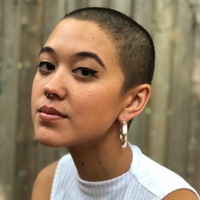On finding certainty in an uncertain field
Prelude
Kara Q. Smith is a professional in the contemporary art world. She has spent the last 13 years working for museums, galleries, and non-profit institutions. She has curated exhibitions, spoken at art fairs and symposiums, officiated workshops and lectures, and written for numerous publications. Throughout her career she has preferenced community-engaging projects and artists who both normalize and complicate notions of identity and place.
Editor’s note: This essay is the fifth piece to be published as part of Conditions, a new series exploring how various forces affect our ability to live fulfilling, creative lives.
Conversation
On finding certainty in an uncertain field
A reflection on hunting for work, and for meaning and sustenance, as a curator
As told to Kara Q. Smith, 2162 words.
I am not an artist. I am also not a crafter, a musician, or a maker. I don’t sing, I don’t dance, and I don’t bake. I do, however, curate. And I love my career making exhibitions, writing, speaking, teaching, and facilitating conversations about contemporary art and ideas. Can one make money doing this, my dad might ask? Well, it’s not always straightforward to do so. To get to what conditions make possible the work that I (and many other curators) choose to do, we first must look at why one might pursue this career despite the narrow odds of making it work financially, and how the work translates not just into a profession, but into a way of interacting with the world.
1: Why curate?
For me, being creative is exercised through my work, which essentially boils down to supporting the creative efforts of others. I developed this career path because, on a deep level, I love creating contexts for people to intersect with art and artists. Through the creativity of others, I learn, among other things, new ways to see and think, to make connections and to be challenged. These are all ways of finding and sharing meaning with myself and others, and a way to stay inspired, which in turn influences other aspects of my life on earth.
To engage with the practice of curating in its many forms is both to have a voice and be able to give voice to others. To create dialogue. To engage with audiences of all walks of life, to question what is known or understood. It’s an effort to find meaningful intersections between art, life, and ideas, which can even include delving into other fields such as science, technology, or psychology. The work of a curator is not just isolated to one industry or one way of thinking about what art, or the world, is—it is expansive, shifting, and personal.
There is also the business side of being a curator: the paperwork, the painting of walls, the institutional initiatives, the archiving, the fundraising, the hiring and training staff—I enjoy all of this, too. It makes the job skillset translatable and scalable to other industries and new types of projects. And this is important when, as I’m doing right now, you find yourself quantifying your career and strategizing how to find a new job opportunity that can both pay the bills, and satiate your desire to work with art and artists. Inevitably, this difficult job hunt will make you ask yourself why you are doing this, and how you might survive while continuing to do it (keep reading).
2: On the title of “curator”
Thirteen years ago, I moved to San Francisco to pursue a career in the art world. There are certainly other cities with a mixture of museums, art schools, and a host of commercial and alternative galleries that I could have moved to, but I had a connection here—both personal and spiritual. With its mixture of profitable industries, network of urban centers, history of touting artistic expression/freedom and innovation, the Bay Area seemed an idyllic place where artists and arts workers could survive and succeed. And when compared with other large metropolitan areas, it consistently makes the list of top vibrant arts communities (see this report). This data, however, doesn’t point out how difficult it is to make a salary as an artist or arts worker in a region where making six figures is now necessary to maintain an average lifestyle amidst skyrocketing rents and costs of living. Even when one might secure a full-time position as a curator, there is rarely a guarantee of job security.
For context, the job title I held most recently was that of Assistant Curator within an arts institution. I held this position (quite happily, I might add) until it was eliminated from said organization last year due to department restructuring. It was a dynamic role, affording opportunities to participate in many facets of creating space for and contextualizing the work of artists in Northern California, both internally and externally. It’s this role of advocacy, often inherent in curatorial positions, that I think make these positions essential for an institution to maintain. But alas, as a recently laid-off curator, I am not alone. Multiple curatorial positions were eliminated or vacated-and-not-replaced in the Bay Area in 2018. This KQED article by Sarah Hotchkiss analyses three examples, including mine, and outlines her own perspective on why curators are important within institutions, and more importantly, a region. Hotchkiss writes:
The quiet elimination of curatorial jobs is a troubling manifestation of a Bay Area arts ecosystem that struggles to find stability despite a booming local economy. Institutions “restructure,” “return to their core missions” and “redefine their priorities” in attempts to both clarify their role within a competitive field of development dollars and audience attention and pare down budgets.
So where does someone who identifies as a curator go when there are currently no arts-related positions that contain the word “curator” posted in the Bay Area? In fact, as of writing this, only just over 20 such jobs were posted for positions across the United States. This might be a narrow time-based slice of data, but I think it is illuminating—and unlikely to change much in the future.
To say the least, the lack of available positions, in the Bay Area in particular, is disappointing and discouraging to this committed Bay Area resident and curator seeking gainful employment. Curators are promoters of creativity and artistic practices, both within institutions and within the public realm. They create opportunities for artists to take risks, to fail, and to explore new ideas. They care for objects and people. And often, in my experience, curators (though I know this doesn’t apply to all) attempt to hold institutions accountable, to consider power, equity, and constituents when presenting works or projects, something that simply cannot be done enough when you consider the imbalance of authority and representation within the art world, and within the larger world, too.
When these positions disappear from institutions, do they appear elsewhere? Honestly, it’s hard to say how the current situation quantitatively stacks up to previous decades or years. As I consider my own situation of being a curator seeking a job in 2019, I keep coming back to this idea that while a healthy arts scene needs curators, there are no guarantees in this field. But really, when do we find those in life? Is there opportunity in lack of opportunity? That is where one must get creative.
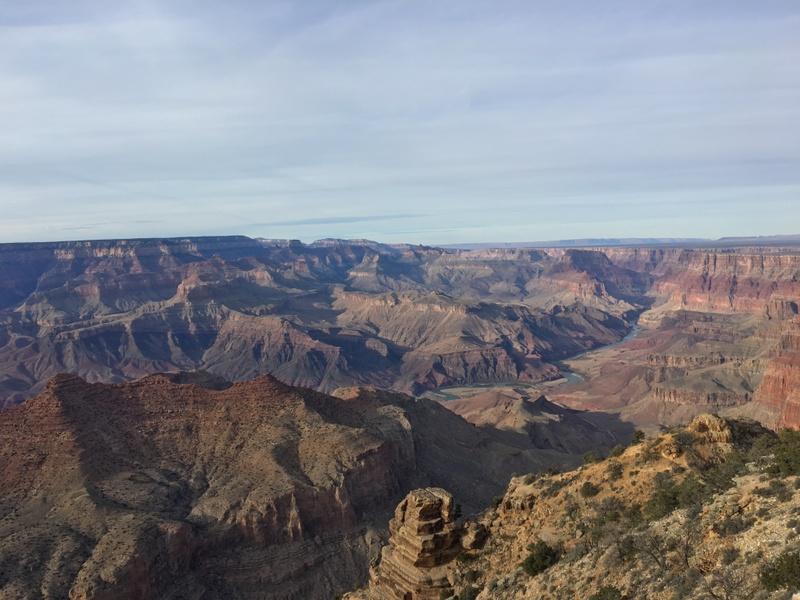
The great expanse of the Grand Canyon.
3: Can this curator make you a cocktail?
As has been outlined, it’s not easy to land a curatorial job title, no matter your credentials. As a professional curator, there have been many times when I have not held the position of curator, and instead, have made a living through other types of positions that dovetail with and have led to curating. Some of these positions include: gallery assistant, unpaid intern, barista, bartender, cocktail waitress, receptionist, program coordinator, art critic, editor-in-chief, curatorial assistant, and project director.
Perhaps what is most interesting about this scatterplot of a resume is not the job titles themselves, but rather what exists in between the dots, or the radius of activity that emanates from each experience: the lectures, panels, roundtables, and conferences I have participated in; all of the essays written; performing student critiques and portfolio reviews; being present at programs, openings, and meet ups… the list goes on. As a curator, staying afloat is more than just landing a job. When your career is your creativity, it’s always about more than the title you hold. You must seek out or create what it is that pushes you, nurtures you, and reminds you why you think art matters so much in our society. The job is the life, and vice versa.
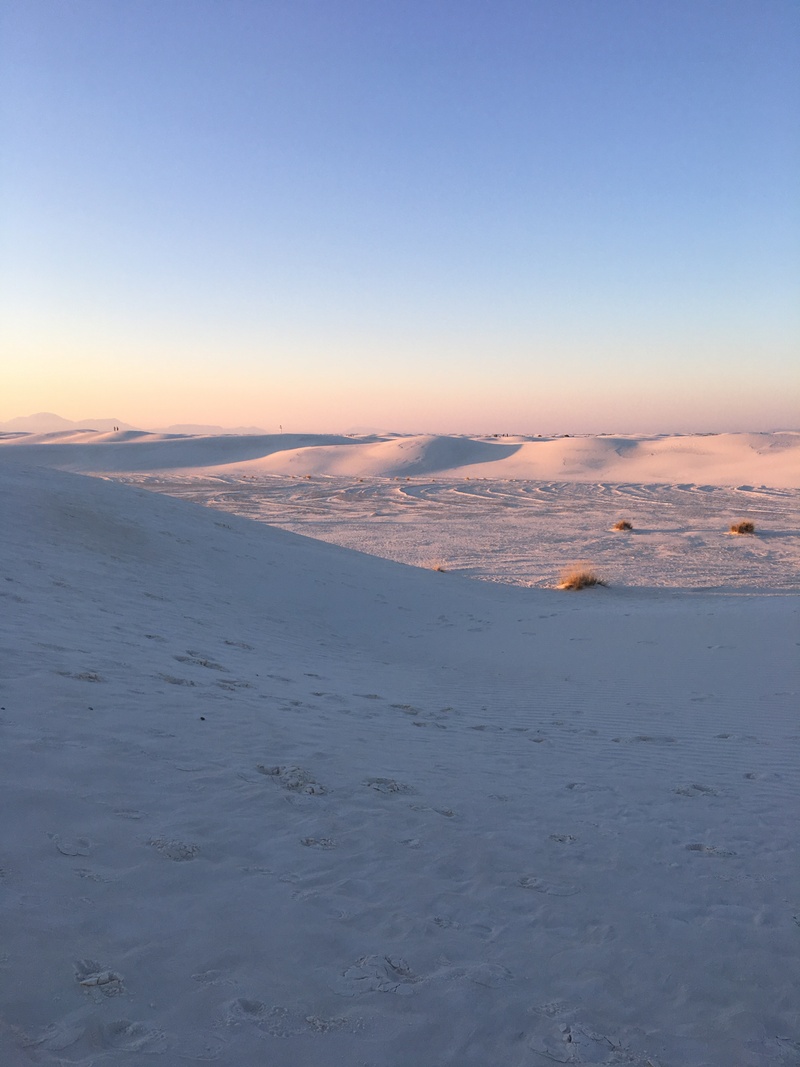
Sunset at White Sands National Monument, NM.
4: On being in-between
Just as the life of a curator is just that, a whole life, I’ve become more attuned to the way my immediate network and community not only inform my practice, but also enable it. As a curator, building a strong community around yourself—one made of of artists, friends, and allies—is a key condition of building a career and staying inspired. Curating doesn’t (or at least shouldn’t) occur in a vacuum. Understanding the gaps, needs, and relationships between people and place impacts my perspective on the work I want to be doing. It is not static. For me, being engaged professionally is a form of personal collaboration. Finding power in collective voices and actions is a philosophical principle of how I approach the work I do, and it’s also why I do it.
And to keep going yourself, you also need a network of generous friends and colleagues to mentor you, assure you, hire you, hold you accountable, and occasionally let you crash on their couch. (I am grateful for you, friends!) One also needs to be generous to herself, to find reprieve on this journey.
In considering the in-between moments of building a profession and a life, I recommend this essay (and book) by artist Jenny Odell on how doing nothing can be a creative tool.
Recently I have found myself seeking ways to take advantage of the in-between times as I wait to hear back about potential jobs (which can be months). Finding downtime to take long walks or just listen to country music for hours can actually be a productive use of time, and I’ve started to see how taking time to do nothing helps keep me nimble. From a physical perspective, you simply need reserved energy to keep going, and from a psychological perspective, you need space to thoughtfully reevaluate your interests and perspectives as you pursue growth and stability. After all, you are creating a career out of something you love, and something that doesn’t always love you back.
Creativity is associated with the imagination, and the production of new ideas. To find this within such a career, one cannot look to just one place. To me, flexibility is related to my passion for this work—of finding the value in shifts, fissures, and discouragements. Being able to listen, adapt, reconfigure, and bring new relevance to the work I do. This process is constant. It is a process of caring, questioning, and participating. To me, this is the foundation of curating, which in turn means that there is no singular title that defines what I do, and thus what opportunities I might seek out.
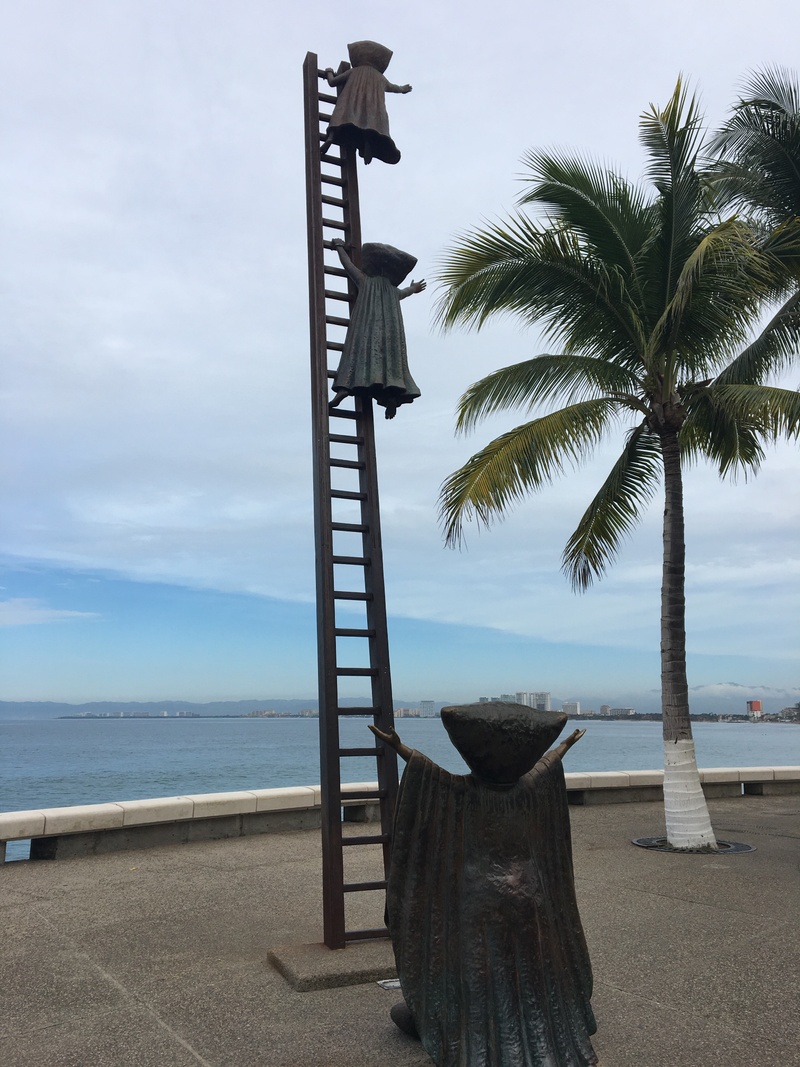
Searching for Reason by Sergio Bustamante, on the boardwalk in Puerto Vallarta, MX
5: Onward
To say the least, unraveling a personal career trajectory on top of a geography of opportunity unearths many complexities. But it is precisely the parts where the two intersect that I find most compelling. There is one steady value in making the unsteady journey of building a career (and a home) in a region where the city lines may be the only thing not shifting; when a place, its history, shifts, and communities become embedded in a person—in their work, their brain, their soul. This is valuable, intangible. And that is what has happened after thirteen years of thinking about place and identity in relationship to contemporary artistic practices, who I am, and what I do.
I plan to continue on this “path,” even though I don’t know where it will lead. If it is elsewhere (either in industry or location), I can say that I will take more with me than I will leave behind. That’s one condition we all want from a career, or a life, right?
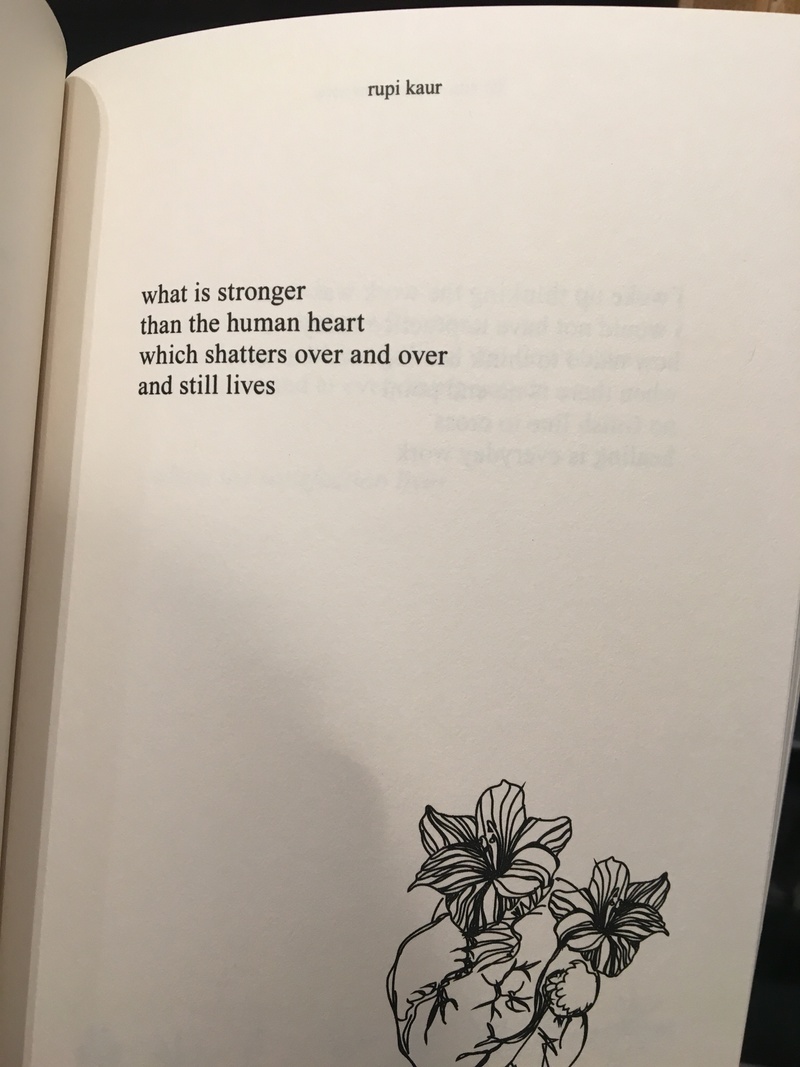
Finding solace in poetry at op. cit. books, Taos, NM.
The photos included in this essay were taken by the author while traveling in between interviewing for jobs during the fall of 2018.
| Symbol: | Weather: | Music: | Location: | Emotion: |
 |
Tempestuous. | Kane Brown, New Orleans Jazz, Solange (depending on the day) | In the wood-paneled, plant-filled living room of my friend Catherine in Oakland, CA. | At times, like the weather, but mostly: resolute. |
- Name
- Kara Q. Smith
- Vocation
- Curator
Conditions report at the time of writing this essay
Pagination
